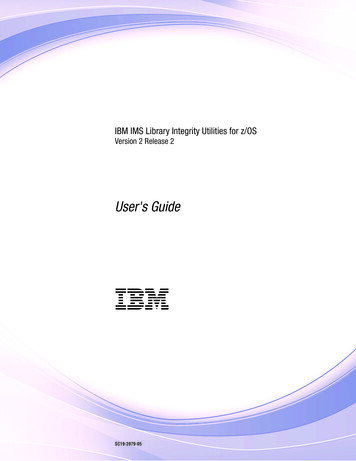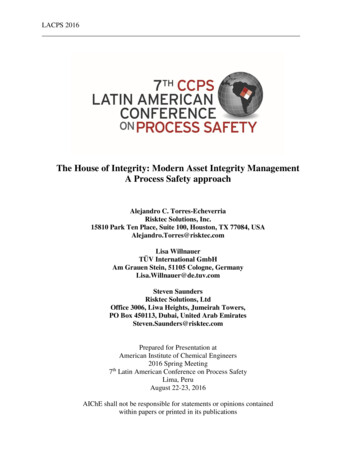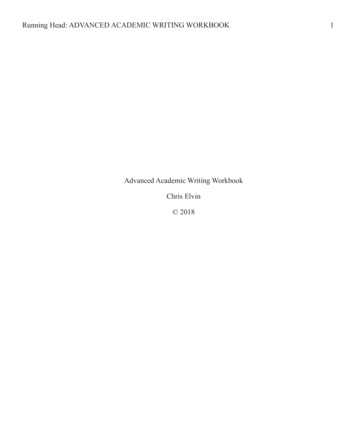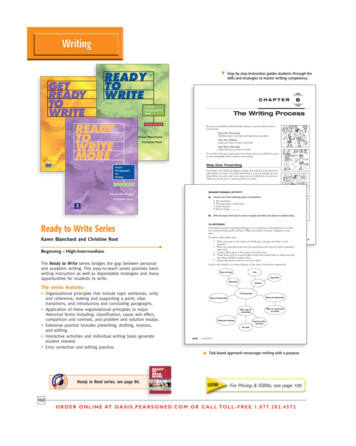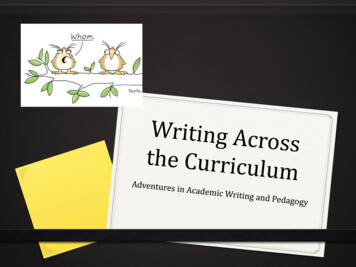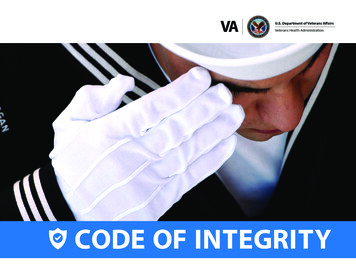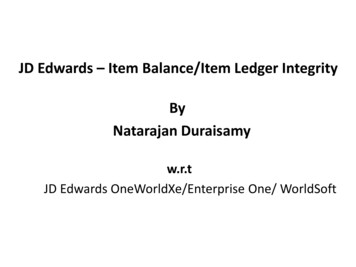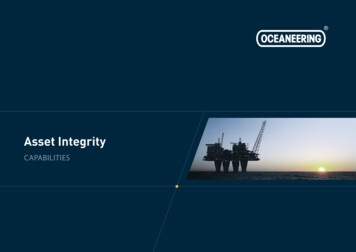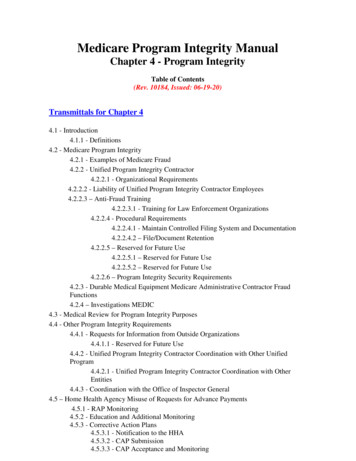
Transcription
““writing codesummarizingAcademicIntegrityat theMassachusetts Instituteof Technology:A Handbookfor Studentsciting facts and demicintegritycollaboration
“AcademicIntegrityat theMassachusetts Instituteof Technology:A Handbookfor StudentsAugust 24, 2012Cover photography:Jim DowIllustration:Richard Cook
table of contents:Academic Integrity at MIT. 2What is Academic Integrity?. 3Violations of Academic Integrity:What are the consequences?. 4What is Plagiarism?. 5Avoiding Plagiarism: Cite Your Source. 6-7What is Common Knowledge?. 8-9Citing Electronic Sources. 10-12Academic Writing at MIT. 13Incorporating the Words and Ideas of Others. 14Avoiding Plagiarism: Quoting. 15Avoiding Plagiarism: Paraphrasing. 16-19Choosing Whether to Quote or Paraphrase. 20Avoiding Plagiarism: Taking Careful Notes. 21Avoiding Plagiarism: Summarizing. 22-23Writing Code. 24-27Collaboration. 28-29Copying and Other Forms of Cheating. 30-31Working Under Pressure. 32-33Helping You Succeed - Resources. 34-35Written by Patricia Brennecke, Lecturer in English Language Studies from 1996-2012.Edited by Anna Babbi Klein, Communications Manager, Office of the Dean for Undergraduate EducationMany thanks to the Academic Integrity Working Group members for their invaluable input: ChristyAnthony, AC Kemp, Heather Konar, Anastasia Maheras ’11, SM ’12, Heather McCann, Stephen Pepper,Anubhav Sinha ’12, and Narendra Tallapragada ’13. Also, thanks to Professors Rob Miller and DanielJackson from EECS for their guidance on “Writing Code” and Stephanie Hatch, MIT’s Social Media andEmail Marketing Specialist, for her guidance on citing social media. And to Professor Margery Resnickfrom Foreign Languages and Literature for her continual support of all efforts around academic integrity.First publication: 2005
writing rationciting facts and statisticsYou are a student at the Massachusetts Institute of Technology because of yourdemonstrated intellectual ability and because of your potential to make a significantcontribution to human thought and knowledge. At MIT, you will be given unusualopportunities to do research and undertake scholarship that will advance knowledge inyour fields of study. You will also face many challenges.As the world becomes more complex, scientists and engineers, as well as humanists,social scientists, managers, architects and planners, need to be able to communicatewhat they know both to each other and to the public. One of MIT’s goals is to graduatearticulate men and women who will be able to take their expertise into the world andcommunicate it effectively. During your academic life at MIT, you will be required tocomplete assignments based on oral communication and writing, some of which willrequire research in libraries and laboratories and accessing electronic resources.MIT anticipates that you will pursue your studies with purpose and integrity. Thecornerstone of scholarship in all academic disciplines is honesty. MIT expects that you willapproach everything you do here honestly – whether solving a math problem, writing aresearch or critical paper, or writing an exam.Some of you may be coming from educational systems where rules of academic integritywere not clearly defined or enforced. Others may be studying in the United States forthe first time and may have different and culturally-based understandings of academicintegrity. To ensure that all MIT students understand the high academic standards ofthe Institute, we have prepared this handbook to help guide you when you approach thewriting, research, coding and test-taking tasks your classes will demand of you.This handbook outlines important information you will need to know about correctlyacknowledging your sources when you write a report, research paper, critical essay, orposition paper. It provides guidelines for collaboration on assignments and writing code.The handbook also provides information about what constitutes violations of academicintegrity and the consequences of committing such violations. Please familiarize yourselfwith this material before you begin work in your classes, and use it as a resource whenyou have questions — at MIT and beyond. Ignorance is never an excuse for academicdishonesty.A note on responsible and ethical conduct of research:This handbook does not address issues related to research ethics, which often arefield-specific. Your research supervisor and department are important sources ofinformation concerning these questions. MIT also offers online research ethicstraining to ensure you have the knowledge and tools you need to pursue yourresearch interests by adhering to the highest academic and personal standards.Through the Office of Sponsored Programs (OSP), anyone in the MIT communitycan take the free online course in Responsible Conduct of Research (RCR) athttp://osp.mit.edu/compliance/rcr. The training provides both fundamental as wellas discipline-specific training.”
What isAcademic Integrity?Fundamental to the academic work you do at MIT is an expectation that you will make choices thatreflect integrity and responsible behavior.MIT will ask much of you. Occasionally, you may feel overwhelmed by the amount of work you need toaccomplish. You may be short of time, with several assignments due the same day. The pressure canbe intense. However, no matter what level of stress you may find yourself under, MIT expects you toapproach your work with honesty and integrity.Honesty is the foundation of good academic work. Whether you are working on a problem set, labreport, project or paper, avoid engaging in plagiarism, unauthorized collaboration, cheating, orfacilitating academic dishonesty. Follow this advice: PlagiarismDoDon’tTrust the value of your own intellect.Don’t purchase papers or have someone writea paper for you.Undertake research honestly and creditothers for their work.Don’t copy ideas, data or exact workingwithout citing your source.Unauthorized CollaborationDoDon’tDo your own thinking.Don’t collaborate with another studentbeyond the extent specifically approved by theinstructor.CheatingDoDon’tDemonstrate your own achievement.Don’t copy answers from another student;don’t ask another student to do your workfor you. Don’t fabricate results. Don’t useelectronic or other devices during exams.Accept corrections from the instructor aspart of the learning process.Don’t alter graded exams and submit them forre-grading.Do original work for each class.Don’t submit projects or papers that have beendone for a previous class.Facilitating Academic DishonestyDoDon’tShowcase your own abilities.Don’t allow another student to copy youranswers on assignments or exams. Don’ttake an exam or complete an assignment foranother student.3 Academic Integrity at MIT
Violations of Academic Integrity:What are the consequences?The consequences for cheating, plagiarism, unauthorized collaboration, and other forms of academicdishonesty can be very serious, possibly including suspension or expulsion from the Institute. Anyviolation of the rules outlined in this handbook or established by the instructor of a class may beconsidered violations of academic integrity. Instructors decide how to handle violations of academicintegrity on a case-by-case basis, and three options exist:Academic consequences within the class itselfThe instructor determines what action is appropriate to take. Such action may include: requiring the student to redo the assignment for a reduced grade. assigning the student a failing grade for the assignment. assigning the student a failing grade for the class.The instructor may also submit documentation to the Office of Student Citizenship in the form of aletter to file or a formal complaint. These options are outlined below.Letter to fileThe instructor writes a letter describing the nature of the academic integrity violation, which isplaced in the student’s discipline file. The discipline file is maintained by the Office of StudentCitizenship (OSC) and is not automatically associated with the student’s academic record. A letter may be filed in addition to the action already taken in the class. The instructor can choose to designate a letter as an informal or formal letter to file. Thisdetermines whether the letter is maintained as an internal record only or could be released. If a student decides to authorize the release of her/his discipline file to a third party (forexample to a graduate school or employer): informal letters to file are not disclosed. formal letters to file are disclosed. If a student receives a letter to file, s/he has the right to: submit a reply, which is added to the student’s file. appeal the letter to the Committee on Discipline (COD) for a full hearing. In resolving the violation described in the letter, the OSC reviews any previous violationswhich are documented in the student’s discipline file.Committee on Discipline (COD) complaintThe instructor submits a formal complaint to the COD, which resolves cases of alleged studentmisconduct. This complaint may be filed in addition to the action already taken in the class. A COD complaint is reviewed by the COD Chair and considered for a hearing. Any previousviolations documented in the student’s discipline file are reviewed as part of this process. Cases resulting in a hearing are subject to a full range of sanctioning outcomes, includingprobation, suspension, dismissal, or other educational sanctions.The MIT Policy on Student Academic Dishonesty is outlined in MIT’s Policies and Procedures 10.2at http://web.mit.edu/policies/10/10.2.html.Questions about these options? Contact the Office of Student Citizenship (citizenship@mit.edu).4 Academic Integrity at MIT
What is Plagiarism?During your academic career at MIT, you will write original papers and give oral presentations thatrequire research. It is important to understand that notions concerning reusing other people’s creativeoutput vary from discipline to discipline and culture to culture. For example, in the United States ourcopyright law does not protect ideas or facts, but does protect the particular, original expression of anidea in words or images when they are expressed in a tangible form.In some cultures, the concept of “owning” words that are arranged in a particular sequence mayseem strange. Students from these cultures may have been encouraged to repeat the words of othersand incorporate them into their own writing without quoting or otherwise indicating that they camefrom another source. Other cultures accept the practice of copying phrases or sentences into a paperwithout using quotation marks as long as the writer shows where they came from. These practices notacceptable in North American academic culture.Creative expression of ideas through words, images, and other media is the lifeblood of this academicculture. For this reason, we expect that our original expressions should not be used by others withoutattribution and acknowledgment.Plagiarism occurs when you use another’s words, ideas, assertions, data, or figures anddo not acknowledge that you have done so.If you use the words, ideas, or phrasing of another person or from published material, you must Use quotation marks around the words and cite the source, orParaphrase or summarize acceptably and cite the source.If you use charts, graphs, data sets, or numerical information obtained from another person orfrom published material, you must also cite the source.Whether you quote directly or paraphrase the information, you must acknowledge your sources byciting them. In this way, you have the right to use another’s words by giving that person credit forthe work s/he has done.s o urce5 Academic Integrity at MIT
Avoiding Plagiarism:Cite Your SourceWhenever you take information from a source, whether that source is published on paper, presented ina lecture or broadcast, or made available online, you must tell your reader where the information camefrom: that is, you must cite your source.What does it mean to “cite” a source?In writing a paper, it means: You show, in the body of your paper, where the words or information came from, using anappropriate format,and You provide complete information about the source (author, title, name of publication, date,etc.) at the end of your paper, in the bibliography (also called the works cited or referencespage, depending on the style you use).Note: Different disciplines use different citation styles. We discuss this further onpage 14. If you are unsure which to use, check with your instructor.In giving a formal presentation, it means: You acknowledge, on your slide, where the graph, chart or other information came from.In writing a computer program, it means:You use comments to credit the source of any code you adapted from an open source site orother external sources. Generally, providing a URL and the date of retrieval is sufficient. You alsoneed to follow the terms of any open source license that applies to the code you are using.Why should I cite my sources? To show your readers that you have done your research. To give credit to others for work they have done. To point your readers to sources that may be useful to them. To allow your readers to check your sources, if there are questions. iting sources points the way for other scholars. Future generations of engineers, scientists andCleaders will look to work done at MIT to solve some of the world’s greatest problems. Citationhelps that process continue.6 Academic Integrity at MIT
Avoiding Plagiarism:Cite Your Source (continued)What should I cite? Print sources: books, journal articles, newspaper – any material published on paper. Electronic sources:Articles retrieved from databases such as Lexis-Nexis and ProQuestPersonal and organizational websitesGovernment and institutional websitesBlogsEmail messagesSocial media, such as Tweets and Facebook pagesComputer source codeIn short, any material published or made available on the Internet. Data: geospatial (GIS) data, Census, economic and other types of data published bygovernments, data from surveys, economic indicators, bioinformatics data. Images: charts, graphs, tables, illustrations, architectural plans, photographs. Recorded material: television broadcasts, podcasts or public speeches. Spoken material: personal conversations, interviews, information obtained in lectures, postersessions, or scholarly presentations of any kind.The MIT Libraries provides additional guidance on what, why and how to cite:http://libguides.mit.edu/citing.icontr rceceel souDataSM ociaed liaticArles7 Academic Integrity at MIT
What isCommon Knowledge?You may have heard people say that you do not have to cite your source when the information youinclude is “common knowledge.” But what is common knowledge?Broadly speaking, common knowledge refers to information that the average, educated reader wouldaccept as reliable without having to look it up.This includes:Information that most people know, such as that water freezes at 32 degrees Fahrenheit or thatBarack Obama is the first American of mixed race to be elected president.Information shared by a cultural or national group, such as the names of famous heroes or eventsin the nation’s history that are remembered and celebrated.Knowledge shared by members of a certain field, such as the fact that the necessary condition fordiffraction of radiation of wavelength from a crystalline solid is given by Bragg’s law.However, what may be common knowledge in one culture, nation, academic discipline or peer groupmay not be common knowledge in another.To help you decide whether information can be considered common knowledge, ask yourself: Who is my audience? What can I assume they already know? Will I be asked where I obtained my information?Some examples:A description of the symptoms of Asperger’s Syndrome would need to be cited for a compositionin a general writing class but probably not need citation for an audience of graduate students inpsychology.A reference to the practice of fair value accounting would be understood by a group ofeconomists, but would need citation to an audience of non-experts.A statement reporting that 24% of children under the age of 18 live in households headed bysingle mothers would need to be cited. This is information that would not be known to theaverage reader, who would want to know where the figure was obtained.The best advice is: When in doubt, cite your source.8 Academic Integrity at MIT
What isCommon Knowledge? (continued)Common Knowledge: Yes or No?Consider the following statements. Which would be considered common knowledge? Which wouldneed to be cited?1.The Big Bang theory posits that the universe began billions of years ago with an enormous explosion.2.The phrase “Big Bang” was coined by Sir Fred Hoyle, an English astronomer. Hoyle used the term tomock the theory, which he disagreed with.3.According to the Big Bang model, the initial explosion was produced when an infinitely hot, densecenter referred to as a singularity, began to expand, giving rise to the particles that eventually formedinto our universe.Statement #1 is common knowledge; the Big Bang theory is widely accepted among scientists andthe term is used regularly in everyday speech.Statement #2 needs citation; this information is very specific and may even be unknown to somephysicists.Statement #3 would not need citation to an audience of physics students but would need citationin a paper for a non-expert audience.What is not Common Knowledge? Datasets generated by you or others. Statistics from sources such as the US Census Bureau and the Bureau of Labor Statistics. References to studies done by others. Reference to specific dates, numbers, or facts the reader would not know unless s/he haddone the research.The following statements are not common knowledge and would need citation:Researchers have found that dispersants utilized to clean up oil spills can lead to lung damage whenairborne particles of these dispersants combine with crude oil and are inhaled.(Source: Wang, H., Shi, YL, Major, D. and Yang, HL (2012, August). Lung epithelial cell death induced by oildispersant mixtures. Toxicology in Vitro, 26, 5, 746-751. doi: 10.1016/j.tiv.2012.03.011)A recent study by the Brookings Institute found that the number of people living in poverty in Americagrew by 12.3 million between 2000 and 2010, so that by the end of 2010, 15% of the population was livingunder the poverty line.(Source: Kneebone, E., C. Nadeau and Berube, A. (2011, November 3). The re-emergence of concentratedpoverty: metropolitan trends in the 2000s. Brookings Metropolitan Opportunity Series. Retrieved metropolitan-opportunity.)The energy of mixing per site for a binary polymer blend with differing degrees of polymerization can bedescribed through the Flory-Huggins equation.(Source: Flory, P.J. (1953). Principles of Polymer Chemistry. Ithaca, NY: Cornell University Press.)9 Academic Integrity at MIT
Citing Electronic SourcesDo not assume the information you find on the Internet is common knowledge. Everything on theInternet has been written by someone and may need to be cited. Simply including a URL is not enough.Even if there is no visible author, there is other information that should be included in the citation.Consult your style guide on how to cite electronic sources, including social media posts.Different disciplines use different citation styles. If you are unsure which to use, check with yourinstructor. The Online Writing Lab (OWL) of Purdue University provides useful examples of citingelectronic sources for each style: American Psychological Association 60/10/ Modern Language Association 47/08/ Chicago Manual of Style 17/05/Citations of electronic sources often require the URL or the name of the database from which youretrieved the information. Always keep the URL for your own records so you can refer back to it.Cite Creative Commons-licensed ContentWhen you use content made available under a Creative Commons license, follow the terms ofthe specific Creative Commons license attached to the content. All Creative Commons licensesrequire that you cite the creator of the content.In addition to giving credit to the creator, you should cite the content as any other online source.Provide as much information as possible and adapt the citation entry to the style you are using.Also include the URL to the Creative Commons license at http://creativecommons.org/.Do not cite Wikipedia as a SourceMany of us use Wikipedia as a source of information when we want a quick explanation ofsomething. However, Wikipedia or other wikis, collaborative information sites contributed to bya variety of people, are not considered reliable sources for academic citation, and you should notuse them as sources in an academic paper.The bibliography published at the end of the Wikipedia entry may point you to potential sources.However do not assume that these sources are reliable – use the same criteria to judge themas you would any other source. Do not consider the bibliography as a replacement for your ownresearch.10 Academic Integrity at MIT
Citing Electronic SourcesIs the Information Reliable?Articles from online publications and databases often provide an author’s name and credentials so thatyou can evaluate the author’s reliability as a source. However, the reality is that anyone can put up awebsite, create a Facebook page, or post via the multitude of other social media tools.Before you take information from a source you have found on the Internet, assess its reliability bylooking for the following:Name of the author:Is the author a recognized authority? Or is the author a student who has posted his or her paperonline?If the person is not a qualified expert, you should not use the information.Name of the sponsoring institution:Is the sponsoring institution a name that you recognize as a reliable, unbiased source ofinformation? For example, the World Health Organization, The United Nations, The AmericanMedical Association.If you cannot locate this information or you are not sure of the reliability of the institution, do notuse the information.Date of posting:Has the website been recently updated? Is the information current?The relevance of the information can be affected by timeliness of the post. Based on your topic,you need to evaluate if timeliness is critical.Some electronic sources have no clear author. This may include: Government websites and social mediaUniversity, institutional or organizational websites and social mediaWhen using sources without a clear author, always look for the name of the sponsoring institution andinvestigate its reliability. If you cannot locate this information or you are not sure of the reliability ofthe institution, do not use the information.11 Academic Integrity at MIT
Citing Electronic SourcesAuthenticity of Social Media PostsIn evaluating social media posts, first follow the guidelines outlined on the previous page. In addition,the authenticity of the author should also be assessed. Outright imposters, as well as parodyaccounts, have proliferated within social media networks. To assess the authenticity: Some social media tools, such as Twitter, perform their own verification testing, which can behelpful in identifying the “true” account of an individual.A Twitter name is not always indicative of the author’s true identity. Verified Twitter accounts aremarked with a blue check badge next to the name. This indicates that Twitter has verified theidentity of the individuals of these accounts. For example:President Obama uses Twitter to keep citizens informed on current issues. “BarackObama @BarackObama” is President Obama’s verified Twitter account whereas“Barack Obama @theUSpresident” is a parody account. Look at the quality of the previous posts to see if the content is consistent with who the authorsays s/he is.Read any associated bio to see what is said about the individual’s identity, beyond just the name.Does the bio link to his/her website, book site or blog? Can you verify the author’s credentials onLinkedIn or similar sites? If you are in doubt of the person’s true identity, do not use the source.When you do cite a social media source, cite it by its handle or vanity URL, not by the name itprofesses. This ensures you are accurately reflecting your source to the reader.For example, if you found the Twitter feed @cola78456 listed as Coca Cola Company andyour assessment led you to believe it was authentic, you would cite the source as:“@cola78456 says ” not “Coca Cola Company on Twitter says ”In some cases, you may want to quote social media posts by “everyday people” to help exemplifya viewpoint or trend. In this case, the challenge is not assessing the authenticity of the author, butdetermining if the person is real and not an automated web “bot.” To assess if the author is real: Check the quality of previous posts. Bots tend to post spam and re-post content of others.Consider the tone of the posts. Bots typically post a statement and a link. Opinions andsentiments usually come from a real person, not a bot.If the social media account is being curated, it is more likely a legitimate person.If you are in doubt whether to social media post is from a person or bot, do not use thesource.The MIT libraries provide excellent guidance on finding and evaluating internet sources. For advice on finding good websites:http://libraries.mit.edu/quality-web For advice on evaluating scholarly information:http://libguides.mit.edu/evaluateinfo For a subject specialist who has expertise in finding web resources:http://libraries.mit.edu/experts12 Academic Integrity at MIT
Academic Writing at MITThroughout your academic career, you will be required to write papers for which you will need todo research in books, journals, electronic media, and other sources. One of the challenges of goodscholarship is to take what has already been done, said, or argued, and incorporate it into your workin an original way. To some students, this task may seem unnecessarily redundant: a student writinga paper on the benefits of stem cell research may ask, “If the positive aspects of this research havealready been argued, why do I need to do it again?” The answer is that: by doing research on your subject, you become more familiar with existing scholarly work,which in turn can provide models for your own writing your way of presenting the information and arguing it will be different from that of others andis therefore valuable; and as more recent information on your subject becomes available, you have the opportunityto bring this information into your report or argument, adding new dimensions to thediscussion.Sometimes the goals of academic writing may seem contradictory.On the one hand, we ask you toFind what is written on a topicand report it, demonstratingyou have done your research,BUTwrite about the topic in an original way.Bring in opinions of experts andauthorities,BUTdo more than simply report them;comment on these opinions, add tothem, agree or disagree with them.Notice articulate phrasing andlearn from it, especially if youare trying to enhance yourcapability in English,BUTuse your own words to paraphraseaccurately or quote directly when youincorporate this into a paper.Academic writing is a challenge. It demands that you build on work done by others but createsomething original from it. By acknowledging where you have used the ideas, work, or words of others,you maintain your academic integrity and uphold the standards of the Institute and of the discipline inwhich you work.(Adapted from: Overview and Contradictions. Purdue University OWL Online Writing Lab. Retrieved July 5, 2012from .)13 Academic Integrity at MIT
Incorporating the Words andIdeas of OthersPlagiarism is sometimes unintentional. It can occur when you try to put information from a source intoyour own words, but fail to do so completely. Often plagiarism occurs not because a student is tryingto cheat, but because he or she has not been taught how to incorporate the words and ideas of othersin the proper way.Several options exist for incorporating the words and ideas of others into your own work: Quote directly: put quotation marks around the words and identify the source. Paraphrase: put the information into your own words and identify the source. Summarize: take the key ideas and paraphrase them and identify the source.The form you use to do this depends on the Citation Style you choose:APA – American Psychological Association Style is often used by history, economics, psychologyand political science.MLA –Modern Language Association Style is
report, project or paper, avoid engaging in plagiarism, unauthorized collaboration, cheating, or facilitating academic dishonesty. Follow this advice: Plagiarism Do Trust the value of your own intellect. Undertake research honestly and credit others for their work. Don't Don't purchase papers or have someone write a paper for you.
